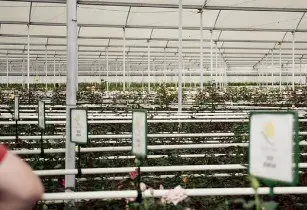At least 125 local and international companies showcased their products and services at the second International Flower Trade Exhibition (IFTEX) recently held at the Oshwal Centre on the outskirts of Nairobi, Kenya
The companies included flower producers, suppliers of inputs and services, supermarkets, auctions and banks.
They were exhibiting at the three-day IFTEX show, globally rated fifth among the leading flower exhibitions.
The East African region and in particular Kenya has become an important source of cut flowers for the global market. Ethiopia and Rwanda have fledging floriculture sectors, rivalled only by Kenya in terms of production and returns.
"Kenya supplied 55 per cent of the flowers sold at Dutch auctions and 40 per cent of the produce in the EU, placing it in a unique market position," observed Dick Raamsdonk, the president of HPP of Netherlands, the event’s organiser.
According to Raamsdonk, Kenya is among the world’s leading supplier of cut flowers and therefore the country should be home to an equally large exhibition.
"Many of the buyers get the flowers after they have arrived in Europe. We feel it necessary that they visit the source," he added, underscoring the increased interest of flower buyers in getting information on where their products are grown.
According to the Kenyan Economic Survey 2013, the cut flower sector earned the country US$765mn in 2012, up from US$692mn in 2011. The country is the lead exporter of cut flowers to the EU controlling 38 per cent of the market share.
Of all exports, 65 per cent are sold through Dutch auction for re-export, 25 per cent to the UK, with Japan, US, Russia, France and Germany making up the rest. Roses comprise the bulk of the exports at 87.7 per cent, followed by carnations at 7.4 per cent and alstroemeria at 1.8 per cent.
"We have participated in many world-class flower exhibitions in Europe, Asia and the US, and it is an honour to have such a show on our land. This show is equivalent to exhibitions in New York, Amsterdam and Ecuador," noted Jane Ngige, chief executive of the Kenya Flower Council, a body that bring together flower producers in the country.
Ngige noted that the flower sector had further opportunities for growth, but challenges such the cost of logistics and packing demanded by the buyers were eating into profits.
"Growers should form marketing firms and team up with exporters. This will give better returns compared with what they are getting through the Dutch auction exports," Ngige added.
The exhibition came at a time when Kenya was on the threshold of making a breakthrough to access the US market directly, providing an alternative outlet for horticultural exports.
"We are still negotiating for direct flights to the US to reduce cost of exportation. Today, we must access the US market through the EU creating logistical problems and increasing costs", said Dr Alfred Serem of industry regulator the Horticultural Crop Development Authority (HCDA).
Access to the lucrative US market is expected to cushion Kenyan growers from shocks brought about by the Euro crisis as well as fluctuations in the EU’s low season. Horticultural produce that can be sold to the US market include cut flowers, fruits and vegetables.
Speaking during the occasion, Kenya’s agriculture cabinet secretary Felix Kosgey said the government has laid out plans that would boost the horticultural sector.
"We will partner with financial institutions – both government and commercial banks – to ensure easy and affordable loans for farmers in the country," Kosgey observed.
During the exhibition, growers and inputs got a chance to establish vital business links for future reference.
Mikyas Bekele, a field officer with Ethiopian Horticultural Producers and Exporters Association, which represents 80 flowers farmers in the country, said, "We are exhibiting for the first time and we have been able to achieve important partnerships that will help up penetrate the flower market."
Bekele noted that the Ethiopian flower sector was catching up with the Kenyan sector and that it was eager to use the three-day event to promote their produce to the global buyers.
Another recent entrant to the flower sector, Trodding Africa Limited, recently won the best growers award for all flowers apart from roses.
Margaret Muthoni, a director at Trodding, remarked, "We are new company having ventured into this business in 2011 but we believe in getting the right quality of flowers before we think of the quality. We are yet to start direct exports ourselves choosing to ship through another local company."
The company has 10 acres of flowers at its two farms located in Naivasha and Kinangop.
A smallholder flower farmer, Richard Kinoti, from Timau region on the shoulders of Mt Kenya, has been attending flower shows since 2004.
Kinoti commented, "It has become an eye opener for me to get vital information on emerging issues in the flower sector. With the digital revolution taking place, it has become important for all farmers to understand important applications that are of help in controlling pests, keeping records and faster communications."
Mwangi Mumero








